-

A collage of five black and white photos of different aspects of the Loyola Fair from the Joe Smajo digital collection.
-

This photograph shows a yellow knit sweater with a crimson letter L on the front. The Monogram Club was started in 1924 and was meant to celebrate the varsity athletes of Loyola. (Photo: Lukas Keapproth)
-
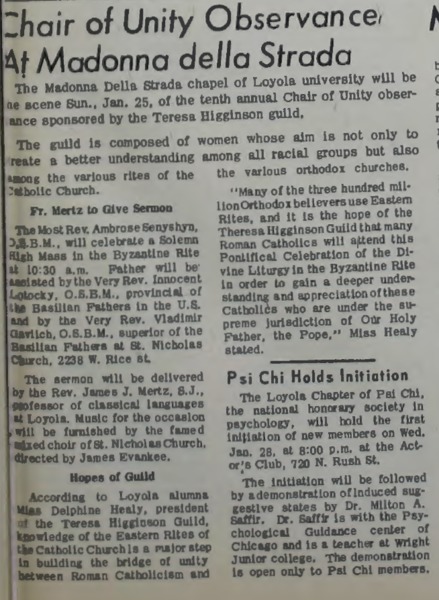
This article gives an overview of the aims of the tenth annual Chair of Unity observance sponsored by the Teresa Higginson guild. The guild's members were women who sought to foster a better understanding among all racial groups and the various rites of the Catholic church. The Chair of Unity observance involved a Pontifical Celebration of the Divine Liturgy in the Byzantine Rite practised by Orthodox believers.
-

Loyola students gather around a group of turtles at the Turtle Race. Most of the turtles remain in the starting circle while two turtles are on the move away from the circle.
The caption reads: Loyola's newest sport, unhampered by charges of commercialism, the Turtle Race. Race photo depicting the start of the race shows most turtles inclined to get their bearings while a few intrepid ones make a bid for sports immortality. Winning turtle had little to say after race, being a bit winded. Rumor has it that turtle ended up in soup bowl.
-

Following the Supreme Court's declaration that states could not create or maintain laws allowing segregated schools on May 17, 1954, unhappy individuals and organizations mounted challenges against the ruling. Loyola students responded to these events by speaking out against segregation and calling for greater racial integration, while remaining aware that the process of desegregation would take a long time. The article also contains examples of the various measures undertaken against the ruling.
-
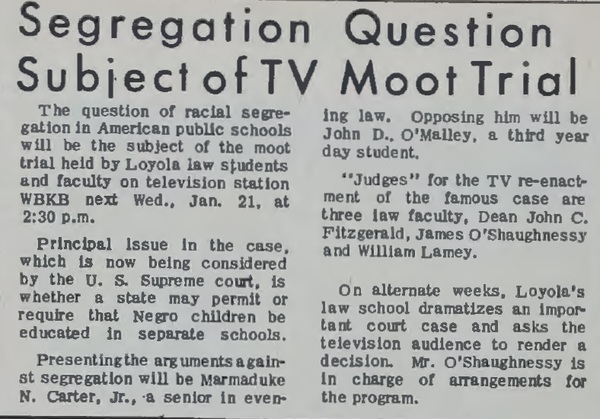
This article contains details of a moot by Loyola law students and faculty that was broadcast on television studio WBKB. Participants were asked to consider the ongoing issue of whether a state could permit or require segregation.
-
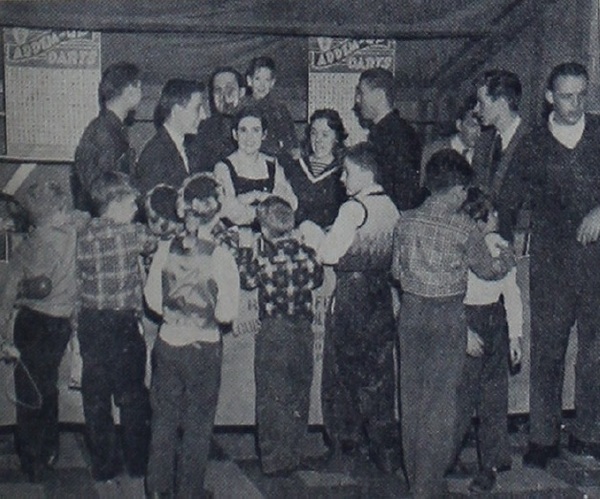
The image shows children surrounding Loyola students during the first Orphans' Party held at the Union House on January 8, 1956.
The article contains details of the first Orphans' Day , which was co-sponsored by six Loyola undergraduate fraternities and two undergraduate sororities. 200 orphans were in attendance and activities included performances by clowns, watching movies and the gifting of presents.
-

Loyola News editors called for Loyola fraternities to stop hazing and instead adopt "constructive projects for their pledges to perform."
-
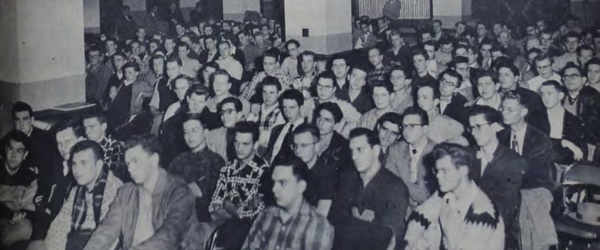
A large group of fraternity members seated in the Union Lounge. Rev. Laurence J Lynch, S.J, dean of students had called for a meeting to request that Loyola's fraternities conduct themselves in a "more business-like" manner.
-
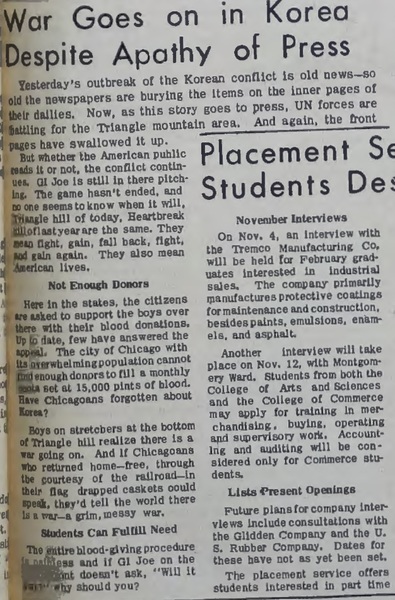
Loyola News editors lamented that newspapers' coverage on the Korean War was being buried in the "inner pages of their dailies." Invoking the grim image of deceased servicemen returning home in their coffins to emphasize the reality of the Korean War, the editors also called for readers to contribute to blood drives.
-
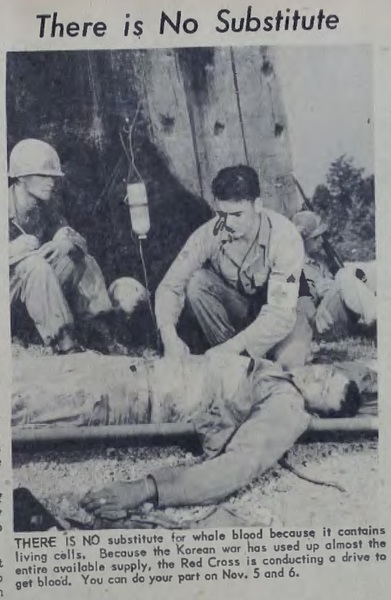
An individual attends to a patient lying prone on a stretcher placed on the ground while another individual wearing a helmet looks on the scene. Another individual can be seen sitting on the ground with their rifle held upright in the background.
The caption below reads: "There is no substitute for whole blood because it contains living cells. Because the Korean war has used up almost the entire available supply, the Red Cross is conducting a drive to get blood. You can do your part on Nov. 5 and 6."
-
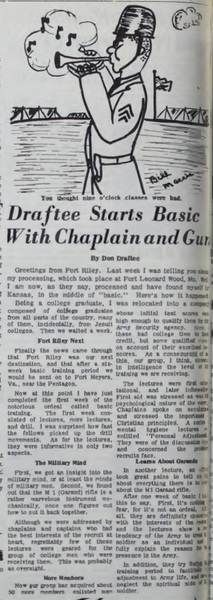
This article contains a comic of a soldier playing the trumpet against a background of tents. The caption beneath the comic reads "You thought nine o'clock classes were bad." Authored by Don Draftee, the article appears to be part of a recurrent column that followed a draftee through the conscription process. This particular article contained details on the lectures and drills conducted during basic training.
-
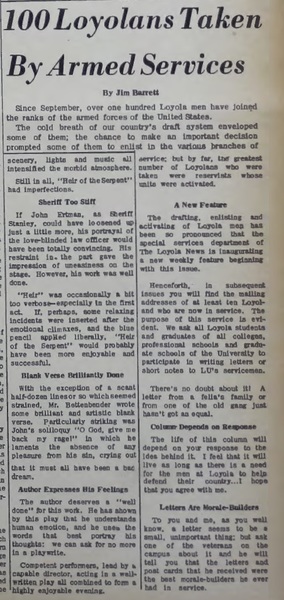
In response to the large numbers of Loyola students joining the armed forces for the Korean War, the Loyola News announced a new column that would list the mailing addresses of at least Loyolans that students could write to. It was hoped that this initiative would help to boost the morale of individuals in service.
-
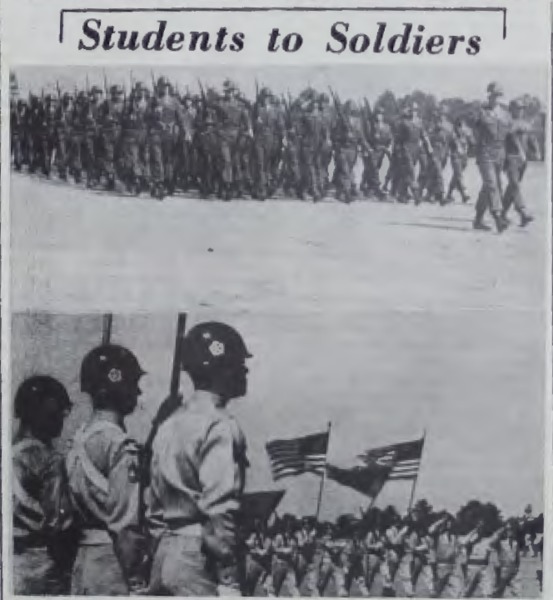
The image is a composite of two images. The top image features individuals in uniform marching and saluting with their rifles held upright. The bottom image features three uniformed individuals standing at attention in the foreground while a group of uniformed individuals bearing the United States flags march past, saluting.
The front page of the October 19, 1950 Loyola News issue was dedicated to various stories on the draft for the Korean War. The issue also announced the start of a new series featuring articles following a Loyola student through conscription.
-
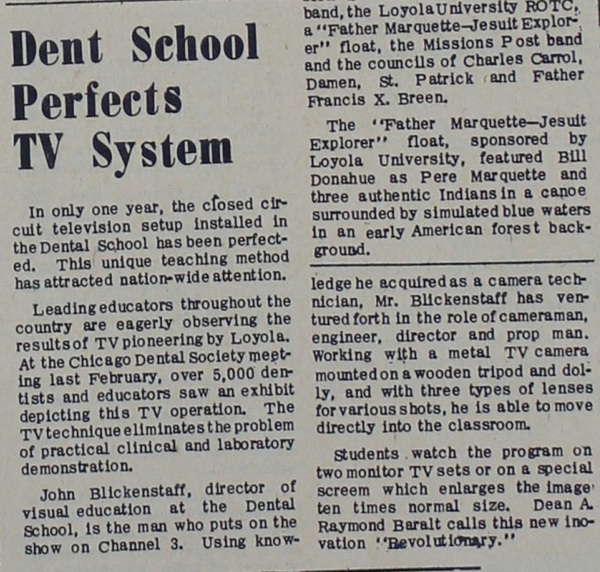
This Loyola News article covers the adoption of TV technology to teach clinical techniques at the Loyola University School of Dentistry. Students were able to view the practical clinical and laboratory demonstrations on screens which enlarged the image "ten times normal size." The pioneering innovation drew interest from educators throughout the United States.
-

From the caption: "Dr. Herbert E. Schmitz, center, chief of staff of the Lewis Memorial hospital and chairman of the department of obstetrics and gynecology at Stritch School of Medicine, performs an operation for the benefit of the doctors who attended the second annual postgraduate conference at Lewis Hospital. The operation was televised on a closed circuit to fifteen receivers located throughout the building."
-
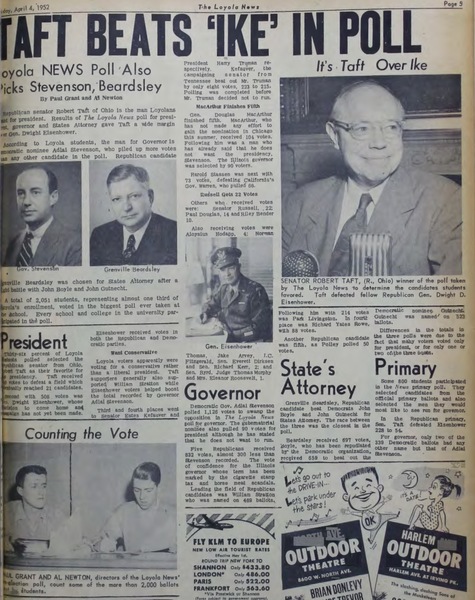
A large article in the Loyola News covers the largest straw poll students had yet conducted, with a total of 2,051 ballots across every school and college in the university. Students chose Republican senator Robert Taft of Ohio for President, Democrat Adlai E. Stevenson for Illinois Governor, Grenville Beardsley for States Attorney. Photos include the winning candidates, and two students (directors of the poll) counting ballots.
-

Item 1: This article by Ray Voros, LT News Editor, covered a discussion that took place at the Loyola School of Law, sponsored by the Historical Society and Alpha Kappa Psi fraternity on March 10, 1955 between Chicago mayoral candidates Republican Robert E. Merriam and Democrat Richard J. Daley. The crowd of students attending overflowed from the room. The article describes each candidate's stances and goals. Daley would become mayor of Chicago for many years.
Item 2: This photo is also on the first page of this issue of the Loyola News. Above the backs of students' heads in the audience, both candidates are visible. Daley is seated, along with the moderator, Don Gralen, while Merriam stands at the podium.
-
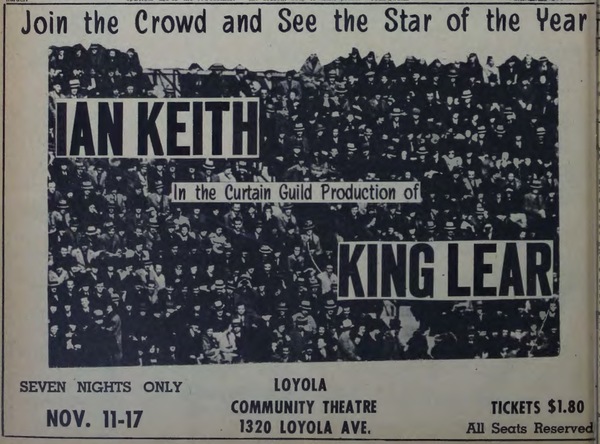
This ad appears in the Loyola News student paper. Over an image of a large, seated audience, the text reads: "Join the Crowd ans See the Star of the Year, IAN KEITH In the Curtain Guild Production of KING LEAR" "SEVEN NIGHTS ONLY NOV. 11-17" "LOYOLA COMMUNITY THEATRE 1320 LOYOLA AVE." "TICKETS $1.80 All Seats Reserved"
Ian Keith was a well-known Shakespearean actor, who performed this play with the Loyola University Curtain Guild in 1951.
-
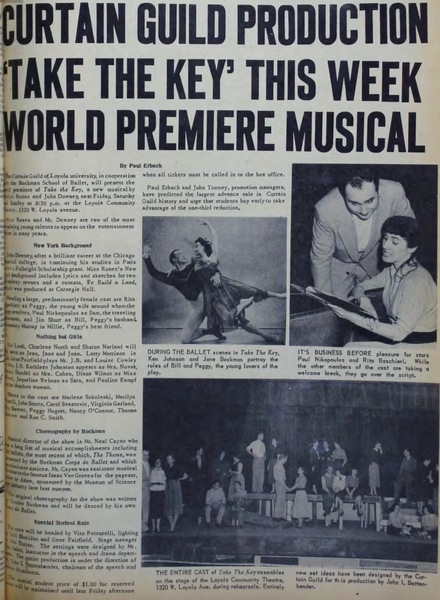
This Loyola News article describes the Loyola University Curtain Guild's latest production at the Loyola Community Theatre, in partnership with the Bockman School of Ballet. It was the premiere of "Take the Key," a new musical.
-
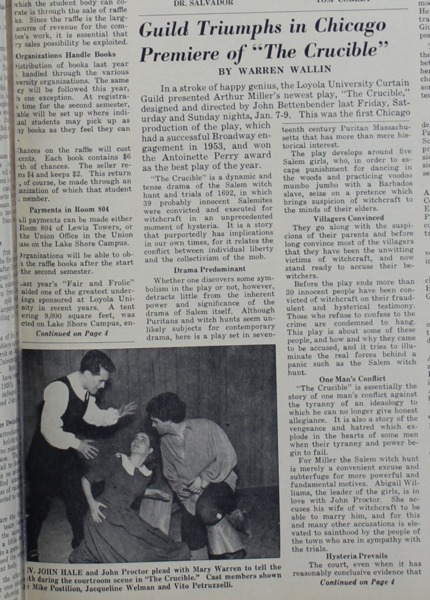
Item 1: Loyola News article by Warren Wallin. This article describes the premiere on Jan. 7-9, 1955 of the Loyola University Curtain Guild production of "The Crucible" by Arthur Miller. The author describes the plot and symbolism of the play set during the Salem witch trials.
Item 2: Detail of item 1. Three students perform a scene from "The Crucible" by Arthur Miller. The caption reads: "JOHN HALE and John Proctor plead with Mary Warren to tell the truth during the courtroom scene in "The Crucible." Cast members shown are Mike Postillion, Jacqueline Weldman and Vito Petruzzelli."
-

Three students man a booth at the Loyola Fair. A banner with letters spelling "LIGHT UP YOUR LIFE" is strung overhead and the back of the booth has display shelves with lamps. The letters for Theta Phi Alpha are on the front of the booth.
-
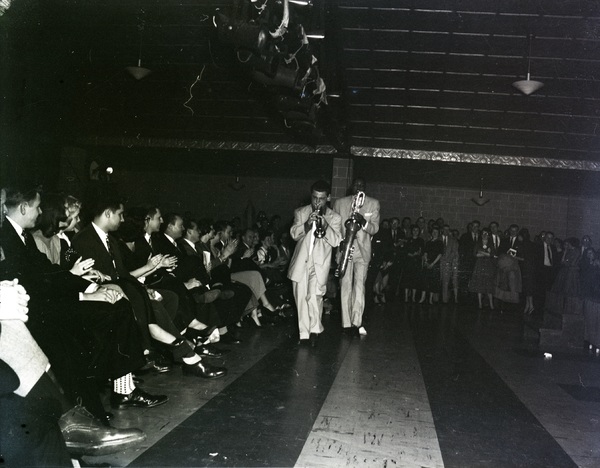
Two musicians, a trumpeter and saxophonist, walk by the audience while playing.
-
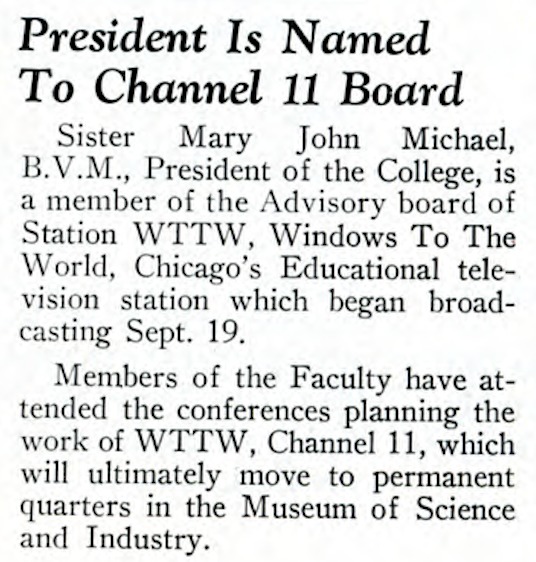
This Skyscraper article mentions that Sister Mary John Michael, BVM, President of Mundelein College was a member of the Advisory board of Station WTTW, Windows to the World. It was founded by Chicago civic leaders as a public station with arts and educational programming, including college courses for credit.
-
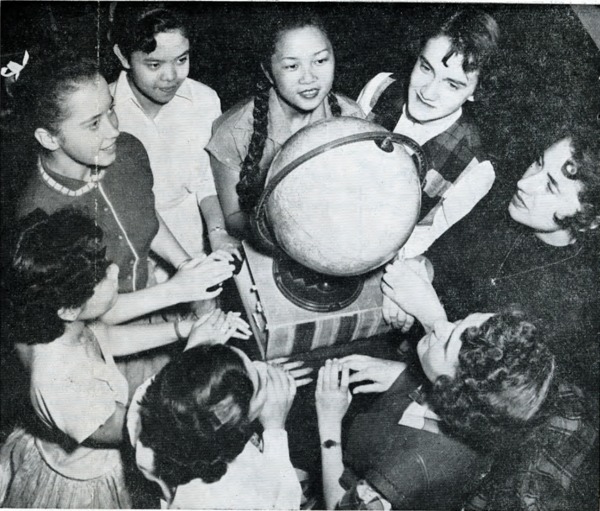
Students from 8 different nations stand around a table holding a globe. The caption below the image reads: "Global interests are shared by students who have lived in 8 nations, including the United States. Clockwise they are Rita Xavier from Japan; Bertrice Hoang from Vietnam; Clair Fogarty from Ireland; Amelita Lasig from the Philippines; Nguyen Kim-Ahn from Vietnam; Janice Zumwalt from Canada; Diane Mitenbergs from Latvia, and Edwina Bynarowick from Poland.

























